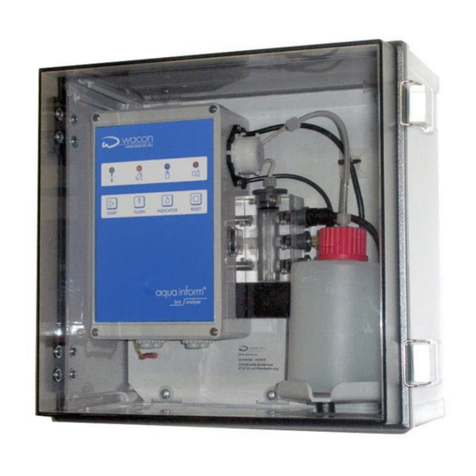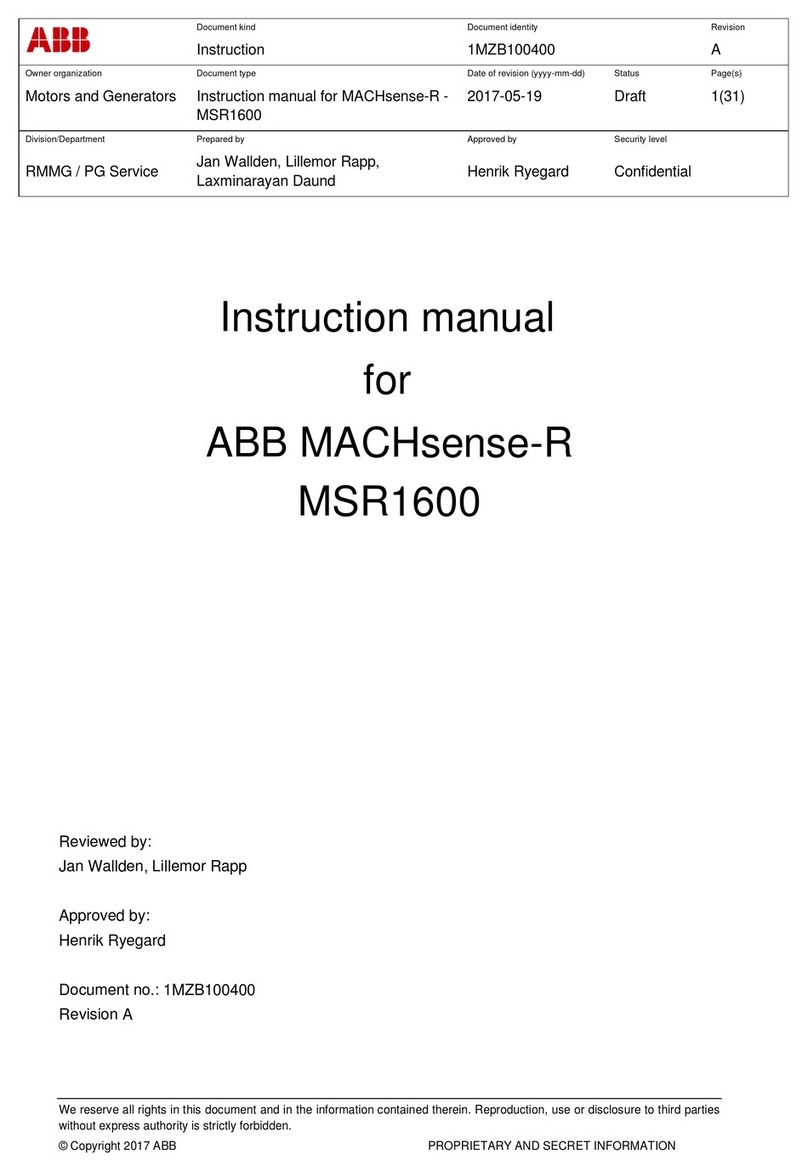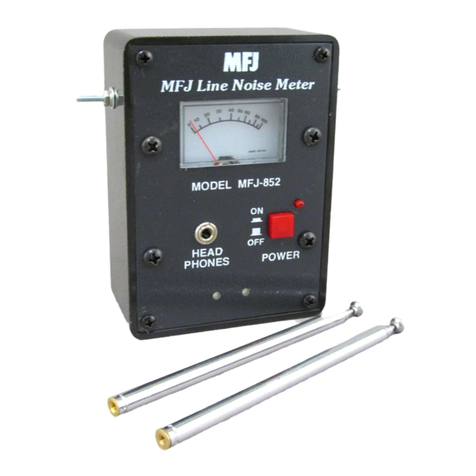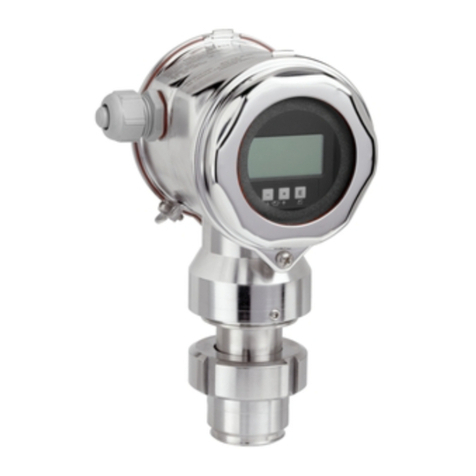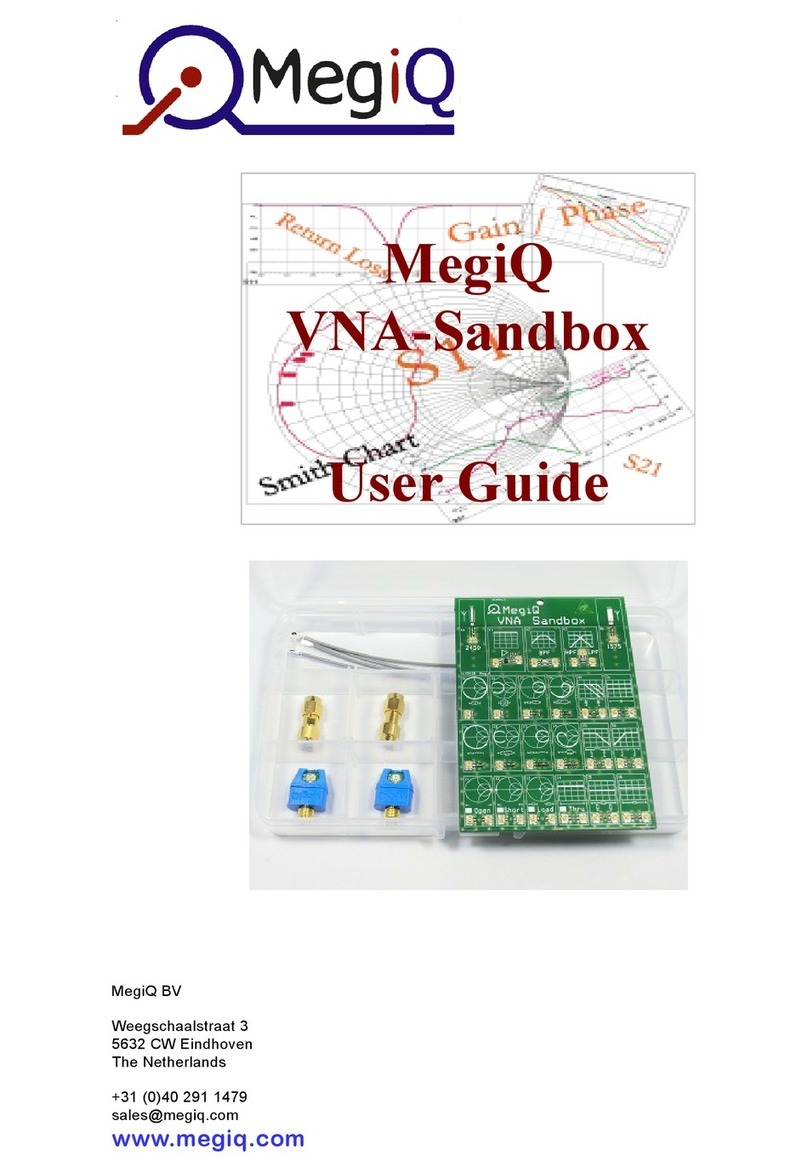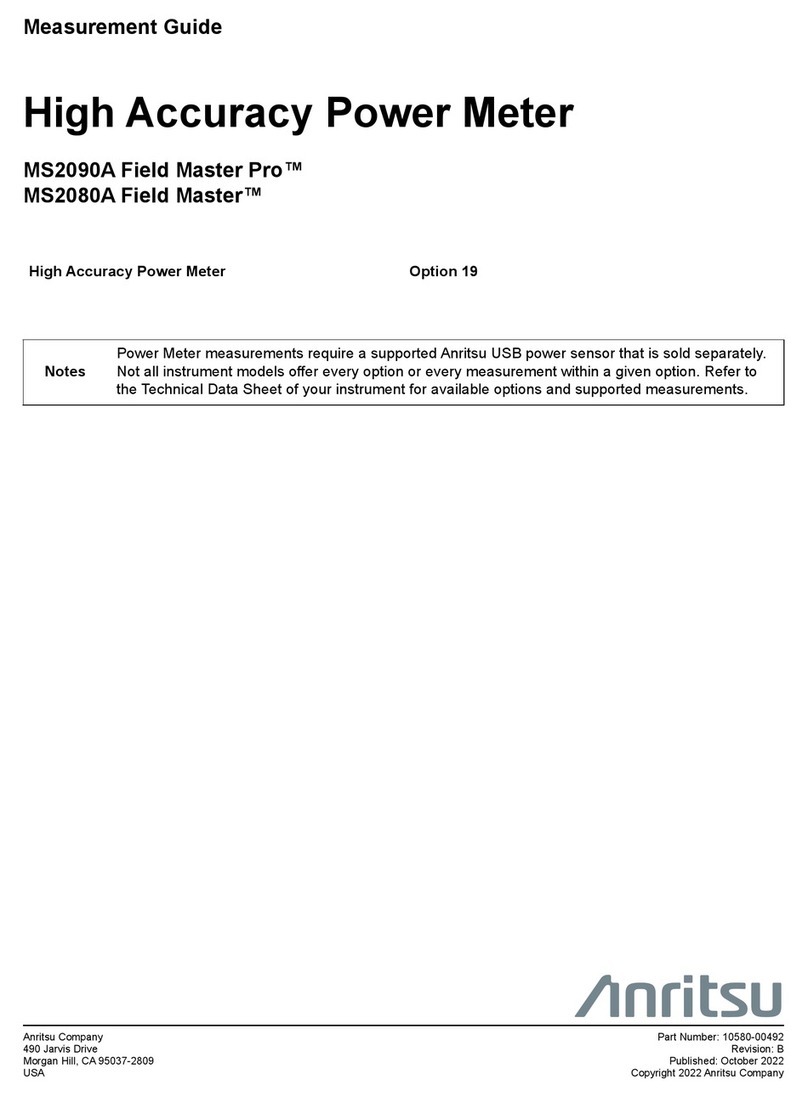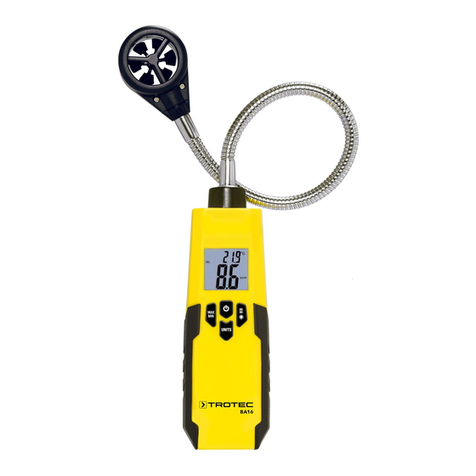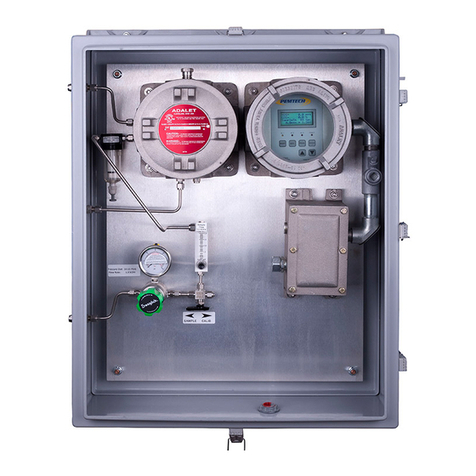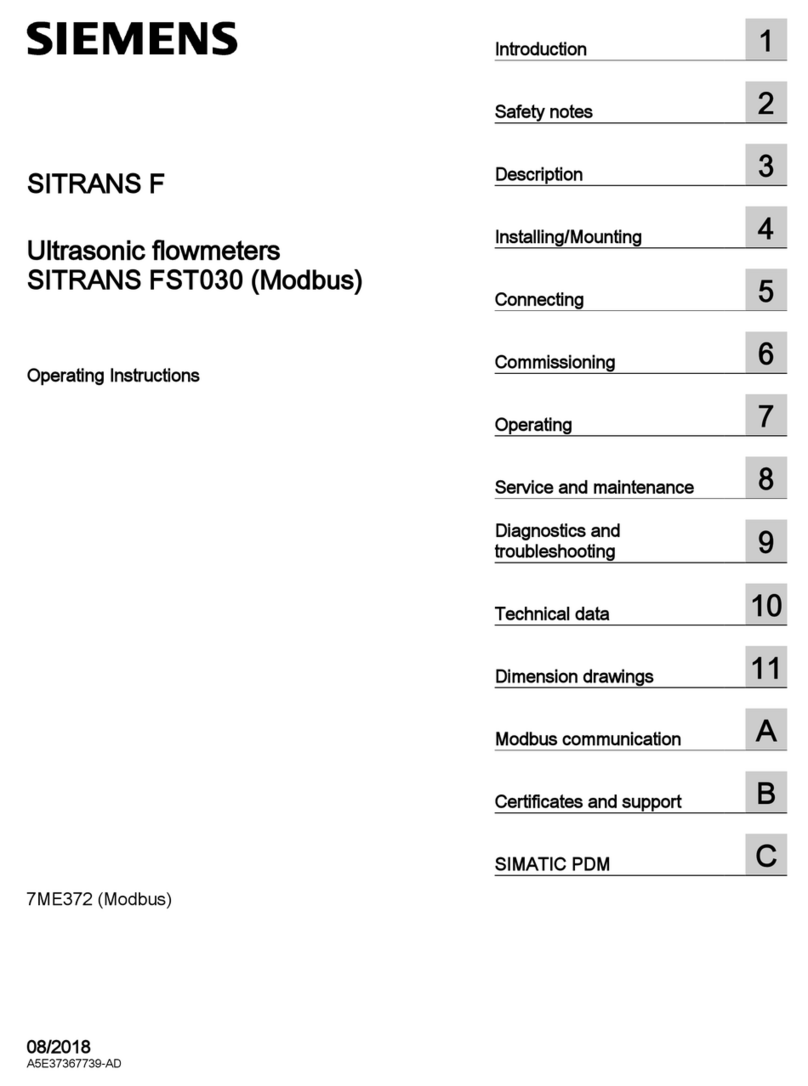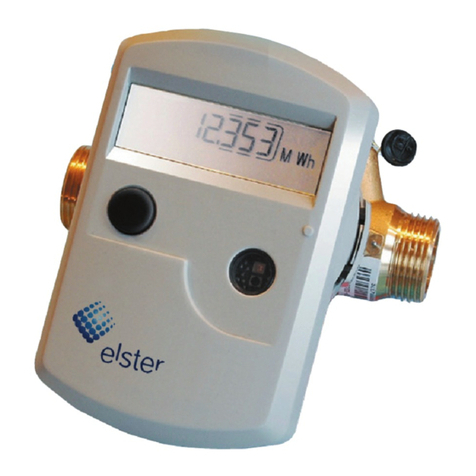Solartron Mobrey MRL800 Instruction Manual

Page 1
IP2028/IM
Installation &
Maintenance
Manual
IP2028/IM
Radar Level
Transmitter
Radar-Based Continuous Level
Measurement
process measurement solutions
!
891
518

Page 2
IP2028/IM
Disclaimer
Solartron Mobrey has made every effort to ensure the accuracy and
completeness of this manual. However, we cannot be responsible for
errors, omissions or any loss of data as a result of errors or omissions.
Solartron Mobrey reserves the right to make changes to the manual or
improvements to the product at any time without notice.
The material in this manual is proprietary and cannot be reproduced in
any form without express written consent from Solartron Mobrey.
Trademarks
All registered trademarks are the property of their respective companies.
Associated Publications
IP2028/SI Safety Instructions (ATEX)
IP2028/QS Quick Start Operating Manual
IP2028/OM Technical Handbook
IP293 Sales Brochure
L2007 Radio Licence Application Pack (United Kingdom)

Page 3
IP2028/IM
Page
1.0 Introduction ........................................................ 7
1.1 Description ......................................................... 7
1.2 How the Radar Level Transmitter Works ...................... 10
1.3 How to use this manual .......................................... 10
1.4 Technical Services ................................................. 11
2.0 Installation Procedure ............................................. 12
2.1 Radio Licensing Approval ......................................... 12
2.2 General installation requirements .............................. 14
2.3 Hazardous area installation ...................................... 14
2.4 Selecting a Location .............................................. 15
2.5 Mounting the Radar Level Transmitter ........................ 16
3.0 Wiring Procedure .................................................. 20
3.1 Wiring ................................................................. 20
3.2 Programming & Commissioning ................................ 21
4.0 Maintenance ........................................................ 25
5.0 Spare Parts .......................................................... 25
Appendices
Appendix A : Rod Antenna : Threaded mounting ................. 26
Appendix B : Rod Antenna : Flange mounting .................... 28
Appendix C : 4” Horn Antenna ....................................... 30
Appendix D : 6” Horn Antenna ....................................... 32
Table of Contents

Page 4
IP2028/IM
Safety Precautions
The following safety precautions should be observed before using this product or
working on the attached cables.
This Radar Level Transmitter is intended for use by qualified personnel who
recognize shock hazards and are familiar with the safety precautions required to
avoid possible injury. Read the operating information carefully before using the
product.
The types of product users are:
Responsible body: This is the individual or group responsible for the use and
maintenance of equipment, and for ensuring that operators are adequately
trained.
Operators use the product for its intended function. They do not require access
to the electrical connections within the instrument, and would normally only
programme the instrument as required.
Maintenance personnel perform routine procedures on the product to keep it
operating, for example, checking the line voltage or checking electrical
connections, replacing fuses etc.
Service personnel are trained to work on live circuits, and perform safe
installations and repairs of products. Only properly trained service personnel may
perform installation and service procedures.
Users of this product must be protected from electric shock at all times. Product
users must be trained to protect themselves from the risk of electric shock.
Before operating the instrument, make sure the supply is connected to a properly
grounded power supply.
Periodically inspect the connecting cables for possible wear, cracks, or breaks.

Page 5
IP2028/IM
To clean the instrument, use a damp cloth or mild, water based cleaner. Clean
the exterior of the instrument only. Do not allow liquids to enter the instrument.
WARNING - If this equipment is used in a manner not specified by Solartron
Mobrey, the protection provided may be impaired.
A protective earth should be used for all applications.
The installation of the Radar Level Transmitter and its associated power cables
must be such that tank overflow, local flooding or pump failure do not cause
these to be submerged or subject to flows of water.
Explanation of symbols:
The IEC Protective Earth Symbol is :
CHECK THAT THE POWER SUPPLY IS SUITABLE
BEFORE SWITCHING POWER ON.
Certification plate
States hazardous area
certification data
Rod antenna model

Page 6
IP2028/IM
Approvals
The Radar Level Transmitter is certified for use in hazardous locations as follows :
ATEX
•
•
FM
•
•
•
CSA
•
•
•
Note :
Refer to the tag on your gauge for the latest hazardous location approval
information.
Detail available once certification
process is complete
Detail available once certification
process is complete
Detail available once certification
process is complete
The Radar Level Transmitter complies with Part 15 of the FCC Rules. Operation is
subject to the following conditions:
1. This device may not cause harmful interference
2. This device must accept any interference received, including interference that
may cause undesired operation
3. Any changes or modification made to this device, not expressly approved by
the party responsible for compliance, could void the users authority to operate
the equipment.

Page 7
IP2028/IM
1.0 Introduction
The Radar Level Transmitter uses an FMCW microwave signal to measure the level
of the process material. The Radar Level Transmitter provides superior
performance to pulsed measurement systems, particularly in hostile
environments, because the continuous microwave signal is unaffected by mist,
surface agitation, temperature changes, or pressure changes.
The standard menu-driven user interface, with built–in help screens and the
optional Windows-based Setup Software are designed to make the Radar Level
Transmitter easy to set up and operate. Full programming details are given in
Technical Handbook IP2028/OM.
1.1 Description
The Radar Level Transmitter consists of an antenna and a factory sealed control
electronics casette. The microwave signal is launched from the RF circuit in the
electronics into the antenna. The antenna serves to focus the transmitted signal
as well as to receive the reflected echo. Both rod and horn style antennae are
available.
Antennae
Verification of chemical compatibility with the exposed antenna materials is
ultimately the responsiblity of the customer.
The standard antenna configuration for the Radar Level Transmitter consists of a
dielectric-filled, 316 stainless steel waveguide with a dielectric rod antenna. The
dielectric rod antenna is PTFE.
The dielectric rod antenna is fitted with either a 1.5” threaded mounting nipple,
welded to the waveguide, or with a welded flange. Waveguides are available in
lengths of 160mm, 238mm or 391mm where the length refers to the portion of
the waveguide that extends below the mounting nipple or the flange. For
optimum performance, the end of the waveguide or the horn should protrude a
minimum of 5mm into the vessel.
The Radar Level Transmitter is also available in options with a horn style antenna.

Page 8
IP2028/IM
Programming
The microwave signal that is reflected from the surface of the process material is
received by the Radar Level Transmitter. Digital Signal Processing (DSP) software
detects the echo and computes the distance to the liquid or solid material in the
tank. The Radar Level Transmitter firmware uses the distance measurement to
calculate the level in the tank.
The Solartron Mobrey Hand Held Communicator (MRL-HHC) can be connected to
the Radar Level Transmitter using the lead provided which allows the user to
interrogate, programme or display values in the transmitter.
The RS-232 connection allows communications with a PC running the Radar
Level Transmitter Window’s based Setup Software.
Note: -
As the cover of the Radar Level Transmitter has to be removed to allow wiring and
connection of a PC or HHC, a work permit or similar will be required if the Radar
Level Transmitter is installed in a hazardous area, in accordance with site
regulations. The cover must be replaced for normal use in hazardous areas.
The HHC and RS232 links are provided for programming and installation only
and must be disconnected after setup.

Page 9
IP2028/IM
Table 1 : Input / Output Characteristics
Options:
The standard electronics cassette may be replaced with a similar cassette having
either Profibus PA or Foundation Fieldbus digital protocol in place of the standard
4-20mA / HART output.
The standard Radar Level Transmitter provides a 4-20 mA current output, with
HART digital protocol super imposed.
Characteristics Table (1) below.
Input / Output Characteristics
Type
Input Power
Current output
Serial
communications
(used for installation
and programming
only)
Service Engineer
connector
Characteristics
13-30Vdc
4-20 mA dc. Full HART
communication.
Isolated, Loop-Powered,
24 Vdc Nominal Supply
Voltage, 700 ohm max. load
RS232 : One 9 pin D type
connector
Comments
18-30Vdc when RS232
connected
One current output is
provided.
See options below.
Half-duplex party line
communication to
Hand-Held Programmer
or P.C.
For trained Service
personnel use only.
RS232 : One 9 pin D type
connector

Page 10
IP2028/IM
1.2 How the Radar Level Transmitter Works
The Radar Level Transmitter generates and transmits a swept frequency
modulated radio signal, which is reflected from the surface of the process
material.
The distance to the liquid surface is calculated by measuring the difference
between the transmit frequency and the received echo frequency; this frequency
difference is proportional to the distance that the microwave signal has travelled..
This highly consistent microwave signal ensures that changes in level are reported
accurately in real-time. A variety of tools are provided in the menus in order to
eliminate any problems which may occur associated with measuring levels in an
active process.
DSP software processes the microwave signal and converts it to measurement
information which is output as a 4-20mA loop current output and may also be
displayed on the HHC readout when connected.
Automatic verification and error correction software continuously monitors system
operations. System faults can be programmed to trigger alarms.
1.3 How to use this manual
This manual details hardware mounting and installation wiring procedures for the
Radar Level Transmitter.
The Radar Level Transmitter Quick Start Manual, IP2028/QS describes how to set
up and operate the Radar Level Transmitter.
Chapter 2.0, “Installation procedure” details the mechanical installation
procedure for installing the Radar Level Transmitter.
Chapter 3.0, “Wiring procedure” details the electrical wiring procedures for
installing the Radar Level Transmitter.
Chapter 4.0, “Maintenance” details maintenance procedures for the Radar Level
Transmitter.

Page 11
IP2028/IM
1.4 Technical Services
Should you experience problems with the Radar Level Transmitter that can not be
resolved with the help of this manual, refer in the first instance to your local
Solartron Mobrey Distributor or Representative.
Contact details can be found on the Solartron Mobrey website at
www.solartronmobrey.com
Main U.K. office and Solartron Mobrey international headquarters is located in
Slough, United Kingdom.
Main Office
Phone: +44 (0)1753 756600
Fax: +44 (0)1753 823589
Web Site: http://www.solartronmobrey.com

Page 12
IP2028/IM
2.0 Installation procedure
The Radar Level Transmitter must be installed in accordance with the instructions
given in this manual.
Radar Level Transmitter models with hazardous area nameplates may be installed
in a hazardous area. Check nameplate for certification data.
The equipment enclosure is manufactured from aluminium with a nitrile gasket
and wetside materials as specified by the ordering code (see appendices). The
characteristics of these materials must be taken into account with regard to
attack by aggressive substances in a hazardous area.
The equipment is intended for use in conditions of normal industrial vibration,
not extreme vibration.
Installation must be carried out in accordance with the applicable code of
practice by suitably trained personnel.
Installation and wiring require no special tools.
2.1 Radio licensing approvals
2.1.1 General
The trasmitted signal is very low poer, less than 10mW.
The Radar Level Transmitter must be securely mounted using the threaded
mounting nipple or flange provided.
If it is inteneded to install the Radar Level Transmitter other than as specified, it
is the responsibility of the user to ensure compliance with local
telecommunications regulations. Solartron Mobrey accept no liability whatsoever
resulting from incorrect installation or use of the Radar Level Transmitter.
Further, although highly unlikely, the user must accept that other users of radar
equipment in the same frequency band may interfere with operation of the Radar
Level Transmitter. On the other hand, if the Radar Level Transmitter is found to
interfere with other users then the user may be required to remove the Radar
Level Transmitter.

Page 13
IP2028/IM
2.1.2 European Union
The Radar Level Transmitter meets all the essential requirements of the
1999/05/EC (Radio Equipment & Telecommunications Terminal Equipment)
R&TTE Directive, ETS 300 440 and ETS 300 683 for installation and use in the
member countries of the EU.
The Radar Level Transmitter operates using a frequency band which is not
harmonised throughout the Community, the product therefore bears the Class 2
equipment identifier, otherwise known as the Alert Symbol, the notified body
number and the CE mark.
It may be necessary to obtain a user or site license to operate microwave
frequency devices in your country. A license is currently required in the United
Kingdom and Norway.
If in any doubt, refer to your Solartron Mobrey Distributor for assistance. Note
also any restrictions on use imposed. It is the responsibility of the user to ensure
any such licence is obtained.
2.1.3 Outside of European Union
Approval requirements vary greatly outside of the EU.
It remains the responsibility of the user to ensure compliance with local
requirements and obtain any licence if necessary.

Page 14
IP2028/IM
2.2 General installation requirements
All installation and wiring must be carried out by qualified individuals in
accordance with any local or national regulations.
The cable entries must be sealed or fitted with a suitable cable gland.
2.3 Hazardous Area Installation requirements : Refer also to IP2028/SI
The Radar Level Transmitter is certified for use in hazardous locations as follows :
ATEX / FM / CSA
• Details available once certification process is complete
•
Note :
Refer to the nameplate on your gauge for the latest hazardous location
approval information.
Warning :
Do not locate the unit in any hazardous area other than those approved.
Follow all installation instructions given in this manual.
1. Do not apply power to the unit in any hazardous area unless the safety
ground is properly wired and the cover is properly installed.
See Section 3.0 for installation wiring instructions.
2. The cable entries into the enclosure must be sealed as stated in Section
3.0.
3. Explosion Hazard - Do not disconnect equipment unless power has been
switched off or the area is known to be non-hazardous.

Page 15
IP2028/IM
2.4 Selecting a location
Selecting a good location to mount the Radar Level Transmitter will ensure
optimum performance and ease of operation of the instrument.
Follow these guidelines when selecting a location for the Radar Level Transmitter:
• The ambient temperature range is –20ºC to 60ºC.
• The Radar Level Transmitter should be mounted above the least turbulent area
of the process material surface.
• There should be a clear path between the Radar Level Transmitter and process
material to avoid false reflections. Verify that the path is clear of pipes,
beams, or any intermittent liquid sprays that could block the microwave
beam. The Radar Level Transmitter beam path is as shown in Table (2) below.
Table(2) Beam diameter with range
• If the tank is fitted with a stirrer or agitator, the user will need to programme
the Radar Level Transmitter to ignore reflections from uncovered agitor blades.
Refer to Technical Handbook IP2028/OM.
• The mounting location should also avoid horizontal structural surfaces such as
baffle support brackets, side wall joints, and so forth, because these surfaces
reflect a strong false signal. If this cannot be avoided, refer to the section
“False Echo Management” in the Technical Handbook (IP2028/OM).
Range to
Target
1m
2m
3m
5m
8m
10m
12m
15m
20m
25m
30m
Rod Antenna :
α= 27°
0.48
0.96
1.44
2.40
3.84
4.80
5.76
7.20
9.60
12.00
14.40
6” Horn Antenna :
α= 26°
0.46
0.94
1.39
2.31
3.70
4.62
5.54
6.93
9.24
11.55
13.86
4” Horn Antenna :
α= 36°
0.65
1.30
1.95
3.25
5.20
6.50
7.80
9.75
13.0
16.25
19.50
NOMINAL BEAM WIDTH

Page 16
IP2028/IM
• If the vessel has a dome top, a good guideline is to mount the Radar Level
Transmitter away from the vessel’s centre point by at least 10% of the vessel
diameter. If the Radar Level Transmitter is mounted in the centre of the
vessel, the dome top will act as a parabolic antenna, potentially enhancing
“false” echoes due to multiple reflections of the transmitted energy.
• If the vessel has a flat roof, then mounting the Radar Level Transmitter in the
centre is preferred.
2.5 Mounting the Radar Level Transmitter
Mount the Radar Level Transmitter to the tank before attaching any wires or
conduits.
If the Radar Level Transmitter is mounted on a nozzle or stand-off, ensure that
the mounting surface is aligned to within 3° of horizontal.
Note the small grub screw at the bottom of the enclosure adjacent to the
mounting nipple or flange. This grub screw may be untightened, allowing the
enclosure to be rotated on the antenna to position the conduit entry as required.
Do not rotate the enclosure by more than 180°. Once in the required orientation,
re-tighten the grub screw to lock the enclosure in position.
2.5.1 1.5” thread mounting
• The internal diameter of any nozzle must be larger than 50mm. For best
performance, the bottom of the stainless steel waveguide tube must extend
below the bottom of the nozzle by at least 5mm. (See Fig. i below)
Fig. i
5mm
minimum

Page 17
IP2028/IM
To mount an Radar Level Transmitter with the 1.5” thread, simply screw the
threaded mounting nipple into the corresponding fitting on the tank to achieve a
pressure tight seal. PTFE tape or equivalent should be used on the taper
threaded models, or a suitable seal/gasket on the parallel threaded models.
Note: Do not apply force to the housing to tighten the mounting nipple. Use a
wrench on the hexagonal portion (60mm) of the mounting nipple.
2.5.2 Flange & horn model mounting instructions
Check that a suitable gasket is in place before tightening flange bolts. Centre the
gasket on the nozzle flange. Check that the antenna will pass freely through the
nozzle.
Slide the horn antenna into the opening. For best performance the horn should
extend below the bottom of the nozzle by at least 5mm, although the Radar Level
Transmitter will operate in longer nozzle lengths (see Fig. ii below).
Fig. ii
Centre the Radar Level Transmitter flange on the gasket and line up the bolt
holes in the flange and the nozzle flange such that the conduit entries are in the
most convenient orientation for subsequent wiring.
5mm
minimum

Page 18
IP2028/IM
Install the bolts and washers, and attach the nuts. Tighten the bolts in a star-
patterned sequence to equalise compression. (See bolting torques 2.5.3)
2.5.3 Bolting torques
The information in this section is to the best of our knowledge correct. Since
conditions of use are beyond our control users must satisfy themselves that bolt
torques are suitable for the flange/process/conditions of their applications.
2.5.3.1 High tensile steel bolts only
The following recommended torques assume the use of high tensile bolts. If
ordinary carbon steel bolts are fitted see section 2.5.3.2. for bolt tightening
torques for this type of bolt.
Min. torques are in Nm (lbf. ft.). Max. torque = Min +10%.
Flange #150 #300
3” ANSI 230(169) 125(92)
4” ANSI 190(140) 220(169)
Table(3) ANSI flanges, high tensile steel bolts only
Flange PN16 PN40
DN50 185(136) 80(59)
DN80 125(92) 97(70)
DN100 125(92) 150(111)
Table(4) DN flanges, high tensile steel bolts only
Initial gasket Compressed Compression
thickness thickness
1.6mm 1.3/1.4mm 0.2/0.3mm
2.5mm 1.9/2.0mm 0.5/0.6mm
3.2mm 2.3/2.5mm 0.7/0.9mm
4.4mm 32./3.4mm 1.0/1.2mm
6.4mm 4.6/5.1mm 1.3/1.8mm
Table(5) Gasket compression for joints without compression stops, high tensile
steel bolts only

Page 19
IP2028/IM
2.5.4.2 Carbon steel bolts only
If ordinary carbon steel or similar low quality bolts are used the recommended
torques are shown below
The gasket sealing force created by the application of these torques is not
sufficient to withstand full flange pressure rating. To achieve full rating, use high
tensile steel bolts as above.
If in doubt about your bolt/sealing application consult your engineering
department or gasket manufacturer.
Min. torques are in Nm (lbf. ft.). Max. torque = Min +10%.
Flange #150 #300
3” ANSI 54(40) 95(70)
4” ANSI 54(40) 95(70)
Table(6) ANSI flanges, carbon steel bolts only
Flange PN16 PN40
DN50 58(43) 58(43)
DN80 58(43) 58(43)
DN100 58(43) 113(83)
Table(7) DN flanges, carbon steel bolts only

Page 20
IP2028/IM
3.0 Wiring procedure
Warnings :
•All wiring must be carried out by qualified individuals in
accordance with national codes.
• Caution: remove all power from the unit before making any
connections.
• The unit is for connection to SELV voltage levels only.
• The equipment must only be powered from a limited current power
supply in accordance with clause 9.3 of EN61010-1:2001.
Hazardous Areas locations : Refer also to IP2028/SI
• Explosion Hazard - Do not disconnect equipment unless power has
been switched off or the area is known to be non-hazardous.
• Do not locate the unit in any hazardous area other than those
approved. Follow all instructions in this manual.
• Do not apply power to the unit in any hazardous area unless the
safety ground is properly wired and the cover is properly installed.
•The cable entries must be sealed or fitted with a suitable cable
gland.
Non-Hazardous Location Installations :
The cable entries into the enclosures must be sealed to prevent
passage of gas or vapours.
The sealing compound should not be affected by the surrounding
atmosphere or liquids.
3.1 Wiring
The Radar Level Transmitter requires a 2 core screened cable to operate.
Note: It is the users responsibility to ensure that the cable and cable glanding
used are suitable for the environment and temperature of the application.
Table of contents
Popular Measuring Instrument manuals by other brands

Industrial Fiber Optics
Industrial Fiber Optics ML 801 instruction manual
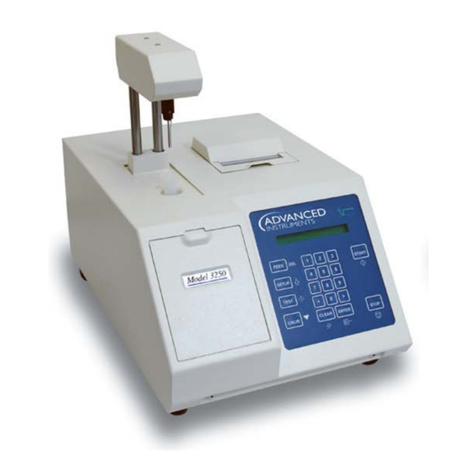
Advanced Instruments
Advanced Instruments 3250 Service manual
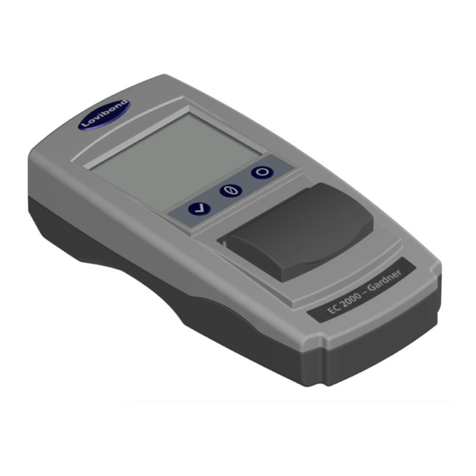
Lovibond
Lovibond EC 2000 Gardner Operator's instruction manual

Blue Line Innovations
Blue Line Innovations PowerCost Monitor user manual

EPI
EPI Valumass 400 Series Installation, wiring & configuration
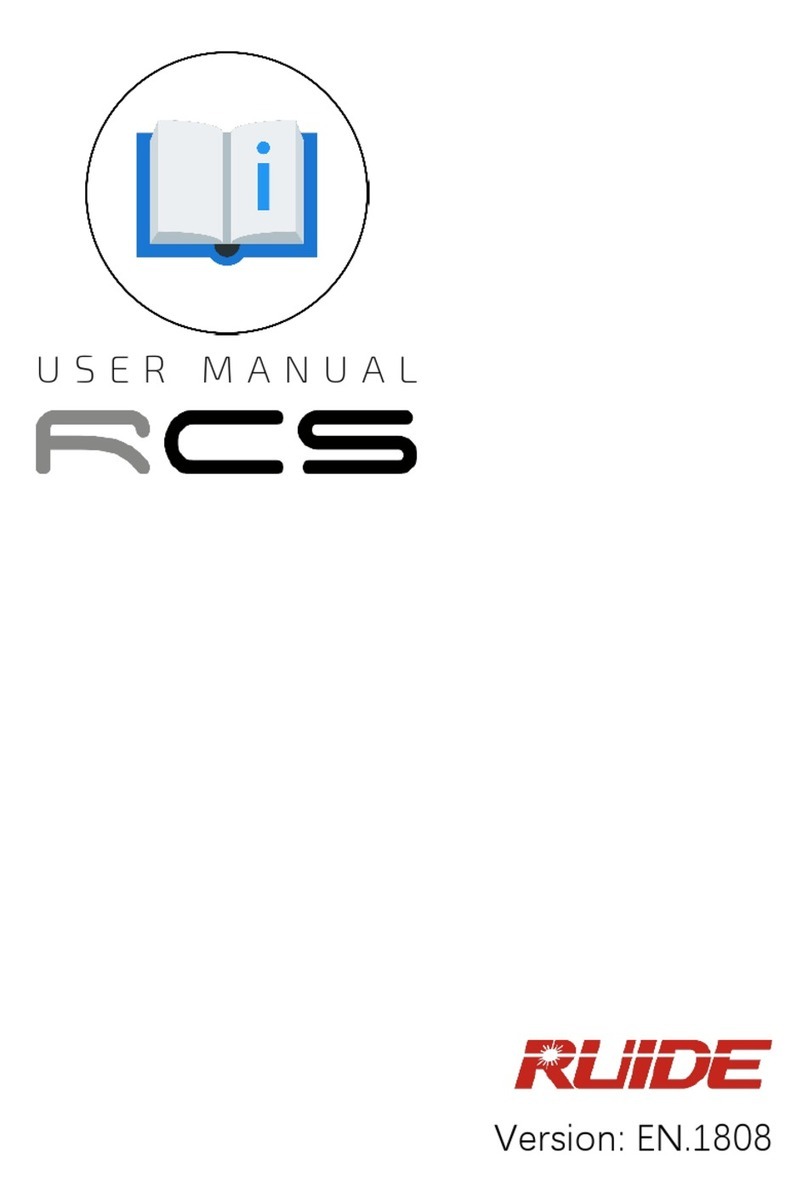
Ruide
Ruide RCS user manual
